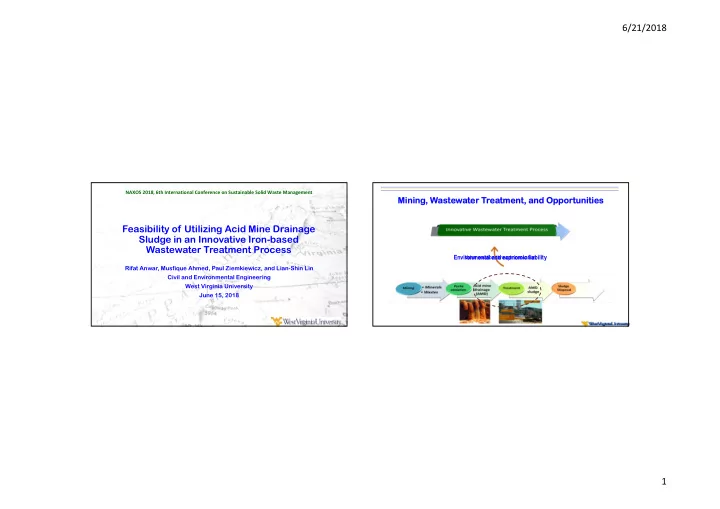

6/21/2018 NAXOS 2018, 6th International Conference on Sustainable Solid Waste Management Mining ng, , Waste stewater T er Trea eatment, a tment, and O Opportuni uniti ties es Feasibility of Utilizing Acid Mine Drainage Sludge in an Innovative Iron-based Wastewater Treatment Process Environmental and economic liability Value creation through innovation Rifat Anwar, Musfique Ahmed, Paul Ziemkiewicz, and Lian-Shin Lin Civil and Environmental Engineering West Virginia University June 15, 2018 1
6/21/2018 Muni nici cipal W pal Waste stewater er Treatment tment Micr Microb obial met l metaboli lism sm Aeration: > 50% electricity utilization • Activated sludge related treatment units: 12 – 17% • O.C. O 2 NO 3 ‐ Fe 3+ SO 42 ‐ CO 2 Nutrients discharge to surface waters • … e ‐ CO 2 emission • (pH 7) Chlorination Lighting and CO 2 H 2 O N 2 Fe 2+ HS ‐ CH 4 Belt filter press 0% buildings 2% 4% Screens 0% Aerated grit removal 1% Wastewater Primary clarifiers pumping Aerobic Denitrifiers Iron Reducing Sulfate Reducing Methanogenic 2% 11% Bacteria Bacteria Microbes Anerobic digestion 12% Max. degrad. rate 8.4 – 13.2 4 ?? 0.5 0.3 Dissolved air floatation (d ‐ 1 ) 12% Yield 0.42 ‐ 0.49 0.25 ?? 0.057 0.035 Gravity air floatation Y (kg VSS/kg COD) 0% Secondary clarifiers Organic C as e ‐ donor, Rittmann and McCarty (2001) 2% Return sludge Aeration puming 51% Burton, 1996 3% 2
6/21/2018 Innovativ tive F Fe(III)-dosed W II)-dosed Wastewater T er Treatmen tment T t Technology gy Main b biogeoc eochemical emical r reacti actions ons • Chemoheterotrophs ‐ Iron reducing bacteria (IRB) Fe 3+ + organics Fe 2+ + HCO 3 ‐ + CO 2 + H + Energy efficiency ‐ Sulfate reducing bacteria (SRB) Reduced Excellent 2 ‐ + organics HS ‐ + CO 2 SO 4 GHG phosphorus emission removal Fe(III) WW Process • Possible chemoautotroph Feammox (Yang et al., 2012) + 3Fe 2+ + 9H 2 O + 0.5N 2 3Fe(OH) 3 + 5H + + NH 4 Useful Low products biological from sludge sludge (magnetite) • Chemical precipitation Fe 2+ + HS ‐ FeS (s) + H + Deng and Lin, 2017; Ahmed and Lin, 2017; Deng et al., 2018 3
6/21/2018 Fe(III)-dosed wastewater treatment Acid Acid Mine Mine Dr Draina nage Sludg Sludge Distribution of major chemical elements in the AMD sludge based on a field survey on 138 AMD sludge cells in Maryland, Pennsylvania, Ohio, and West Virginia. Concentrations are based on the dry weight basis. 4
6/21/2018 Ef Effects of s of pH pH Neut Neutraliz lizer on on Sludg Sludge Comp Composit itio ion Environmental diagenetic and AMD treatment Hydrated lime (Ca(OH) 2 ) Ferric hydroxide and gypsum factors neutralization Ferric sulfate and undissolved Magnesium oxide (MgO) magnesium oxide neutralization Lime (CaO) neutralization Iron and higher calcium content Fe sludge characteristics Iron and lower calcium content Limestone (CaCO 3 ) neutralization WW treatment Iron and aluminum Ammonia neutralization performance 5
6/21/2018 pH pH De Depend ndent t Ferric ic Mine Mineral F l Formation Mine Mineral Phase Phases of of AMD AMD Sludg Sludge Treatment Major mineral phases Reference Schwertmannite, Fe 8 O 8 (OH) 6 (SO 4 ) ∙ nH 2 O Macias et al. 2012 Multi ‐ step passive remediation Hydrozincite, Zn 5 (CO 3 ) 2 (OH) 6 Goethite, FeO(OH) Kirby et al. 1999 Passive pond ‐ based abiotic treatment Jarosite pH < 2.0 Lepidocrocite, γ‐ FeO(OH) Hematite, Fe 2 O 3 Nearly Passive lime bed treatment Lepidocrocite, γ‐ FeO(OH) Aube et al. 1999 amorphous 2.5 < pH < 3.5 Schwertmannite compounds Schwertmannite, Fe 8 O 8 (OH) 6 (SO 4 ) ∙ nH 2 O Florence et al. 2016 Passive vertical flow reactor Goethite, FeO(OH) Magnetite, Fe 3 O 4 NaOH and NH 4 OH neutralization Kefeni et al. 2015 Ferrihydrite pH >5.0 Hematite, Fe 2 O 3 Hausmannite, Mn 2 O 4 Goethite, FeO(OH) Limestone bed treatment Cui et al. 2012 Calcite, CaCO 3 6
6/21/2018 Crystall llini inity & y & Microb obial F ial Fe-r -reduction R eduction Rate te pH Ef pH Effects Less microbial reduction rate Aging Increasing Increasing Crystalline ferric mineral Insoluble ferric mineral pH temperature High crystallinity Increasing pH Increasing pH (Weber et al, 2006 ) (Baltpurvins et al, 1996 ) Slower microbial Fe ‐ reduction rate Amorphous ferric mineral Soluble ferric mineral FePO 4 .4H 2 O > Fe(OH) 3 > γ‐ FeOH> α‐ FeOH> Fe 2 O 3 7
6/21/2018 Conclusions & Fe/Al /Al Pr Products f ucts from AMD - om AMD - Treatment s ment steps Current Status of Technology AMD can be a source of ferric iron for the innovative Fe ‐ dosed • wastewater treatment technology Tremendous opportunities exist for using Fe ‐ containing wastes • for beneficial uses that improve food ‐ energy ‐ water nexus Products efficiencies Selective Final Flocs AMD extraction of • Coated sorbents treatment for separation • FeCl 3 , Al 2 (SO 4 ) 3 Fe and Al discharge Environmental, diagenetic, and AMD treatment are important • factors for Fe sludge characteristics Technical feasibility of the treatment concept proven • Pilot testing to start this summer • 8
6/21/2018 Aging pH Acknowledgement Alkaline • NSF/EPSCoR/AFI Temperature Fe sludge properties treatment • DOE ‐ Size, phase ‐ Composition • WVDEP ‐ Crystallinity ‐ Solubility ‐ Reactivity • Group members: Karen Buzby, Hoil Park, Dongyang Deng, Musfique Ahmed, Rifat Anwar, Alex Panaccione, Alex Rubenstein, Casey Dolan, Nicole Hegele, Oliver Lin, Elbert Rohrbough Microbial Fe(III) reduction rate & pollutants removal 9
Recommend
More recommend